#Pelishor Castle
Text
20 Sights of Romania
New Post has been published on https://tripsterguru.com/20-sights-of-romania/
20 Sights of Romania

Romania is a beautiful country with its own amazing and magical world, with beautiful and picturesque places, a number of attractions that are worth seeing and which are very popular among tourists from all over the world. It attracts with its ancient culture and beautiful nature. Any tourist will find a lot of interesting things for themselves: beautiful views of the Black Sea, Carpathian mountains, clean air, beautiful mountain springs, indescribable beauty, the famous Danube River, historical architectural structures. The sights of Romania can be found anywhere in the country. Each of them has its own story, and even legend. Many of them are nature reserves.
Peles Castle

On the way from Transylvania to Wallachia, on the orders of King Carol I, the Peles Palace was built, which is usually called a castle. It is 135 km from Bucharest. Its construction began on August 22, 1873 under the leadership of the German architect Johann Schulz. It was originally intended as the summer residence of the king and the place of hunting. The central entrance is decorated with a sculpture of King Karol I, who considered his palace to be the “cradle of the dynasty, the cradle of the nation.”
It was here that two Romanian kings were born: Carol II (in 1893) and Mihai (in 1921). The sculpture of his wife Elizabeth, depicted behind embroidery, is located in a secluded corner of the garden. The 3200 m² castle was designed in the Neo-Renaissance style. This building was the first castle in the world to receive electricity. For this, a power station was built on the territory. There are stables, houses for protection and hunting. The tower, 66 meters high, was crowned with a clock.
The interiors are decorated in baroque style. In total, the castle is equipped with 160 rooms, 30 bathrooms, a theater for 60 spectators. An elevator and an air-conditioning system with the help of sliding ceiling windows were built here. Workers from different countries worked on the construction of the castle. According to the estimates of Queen Elizabeth, they spoke 14 languages. In 1947, King Mihai was forced to abdicate, and the castle was confiscated. It hosted tourists, and then in 1958 a museum was created.
During the reign of N. Ceausescu, the castle was under guard, access to it was stopped. The resumption of the museum was short-lived. In 2006, he was returned to the rightful owner of the Romanian king Mihai. The government paid him 30 million euros, and the castle again became available for visits. At present, the castle houses the Historical Museum, the collection of which includes paintings and sculptures from Eastern and Central Europe, silver, gold, ivory, Sevres and Meissen porcelain.
The collected collection of medieval weapons and armor is amazing. There are more than 4000 exhibits in it. Carpets to decorate the interiors of the castle were woven in Bucharest, Mosul, Isparta and Smyrna. Leather goods delivered from Spain (Cordoba). Hand-painted stained-glass windows were brought from Switzerland. The park ensemble consists of seven terraces built in the Italian style. They are decorated with a large number of figures made of Carrara marble by the Italian sculptor Raffaello Romanelli, fountains, stairs. Open for tourists from 9 to 17 hours (Wednesday — Sunday). It does not work in November. It can be visited as part of an excursion group, they gather on the basis of the linguistic principle.
Bran Castle

Built at the end of the 14th century, it was intended for defense and the inhabitants themselves built it. It is located on a cliff 30 km from the city of Brasov and covers an area of 8 hectares. Inside, it has a complex staircase system that allows you to move between four levels. There is a well in the courtyard, which, according to legend, leads to underground rooms. For the construction of this defense fortress, local residents were exempted from paying taxes to the treasury for several centuries. During its existence, the fortress has repeatedly changed owners. But it was called Dracula’s castle, as the lord Vlad Tepes spent the night there during the campaigns and favorite hunting.
There is a legend that Turkish conquerors tortured him in the cellars of the castle. In 1918, the townspeople gave the castle to the Romanian Queen Mary. From that moment, it began to be used as a royal residence. In 1920–26, a grand restoration was carried out, during which a park with fountains, alleys and a private lake spread out on the estate. In 1948, the royal family left the palace; it came to desolation. But already in 1956, the Museum of History and Feudal Art opened at its base.
In 2006, a law was passed in Romania on the return of property to former owners, and the castle was returned to the heirs of the queen. But before that they took out all the historical furniture. Therefore, her grandson Dominique had to re-create the interiors and buy the appropriate environment. Local shops are happy to sell souvenirs related to Count Dracula. In addition, Bran is famous for local cheeses, the recipes of which are transmitted from generation to generation in great secret. Bran is a success with filmmakers around the world. So in 1994, the film “Interview with the Vampire”, shot on the territory of the fortress, was released.
Corvin Castle

Located near the city of Hunedoara, it was presented for outstanding services by the Hungarian King Sigismund to the Romanian military and political figure Janos Hunyadi. He decided to rebuild it and make it a family estate. The restoration was carried out in two stages. During the years 1441-1446, seven towers were erected, in 1446-1453 – a chapel, halls and utility rooms in the southern wing. The heir to the castle was Janos’s son – Matyash Corvin, who continued construction work in the chapel and in the north wing.
The architectural style of the castle includes Gothic elements in combination with fragments of the Quattrocento (early Renaissance). According to legend, the Transylvanian count Vlad Tepes was kept in the dungeons of the castle for seven years after the overthrow. Since 1508, the castle changed owners several times until it was in the hands of Gabor Betlen, who led the anti-Habsburg movement in the Hungarian kingdom. He reconstructed it in the light of the latest fortification requirements.
But in the 18th century, the Habsburgs still began to own it. With them, in 1854, a fire broke out in the castle, destroying the internal wooden finish. During the years 1868-74, reconstruction was carried out here, as a result of which the roof was tiled. During the communist rule, the castle was also reconstructed and opened to visitors.
Poenari

It is located in Arefu (rum. Arefu), a few kilometers from Lake Vidraru. Presumably it was built by Rada Negra, nicknamed the Black Governor. This is the semi-legendary founder of the Vlach state. At that time there was only one tower and a small garrison of guards. In the XV century it belonged to the famous gospodar Vlad Tepes, who did a lot to strengthen it.
He built four more towers, expanded the castle buildings. Traditions say that it was in him that Dracula tortured his opponents. After his death, the area began to fall into disrepair, which aggravated the earthquake in 1888. The last restoration work was carried out in 1972. At this time, they strengthened the masonry walls and built walkways with railings for the convenience of tourists.
Archaeological excavations have confirmed that the fortress in the bed of the Arges river has existed since time immemorial. She allowed to control the territory between Transylvania and Wallachia. To get to the ruins, it is necessary to overcome the 1480 stairs steep stairs leading to the mountaintop Cetatuia. On it is a platform from which, according to legend, the wife of Count Tepes, Elena, rushed into the gorge.
Romanian Athenaeum

In 1865, the Atheneum Society was founded in Romania, and in 1888, the construction of the building began with the funds of the Wallachian boyar clan Wakarescu. In addition, folk money collected under the motto “Donate one leu to the Athenaeum!” Was also used for its construction. This is a concert hall located in the capital of Bucharest. The author of the project was the French architect Albert Galleron. It is built in neoclassical style with romantic elements.
On the ground floor there is a meeting room, and on the second floor there is a visual for 600 seats (52 additional seats are located in the boxes). The interior of the auditorium is decorated with a fresco by the artist Kostin Petrescu depicting significant events in Romanian history. The painting was carried out for 6 years, starting in 1933. On April 22, 1939, a concert was given in honor of the construction of a concert organ.
Performed organ music by Franz Schutz, director of the Vienna Academy of Music and Performing Arts. In front of the Atheneum building there is a small park with a monument to the classic of Romanian poetry, Mihai Eminescu. Currently, the concert hall is considered a symbol of Romanian culture and is listed on the European Cultural Heritage.
Rasnov Fortress
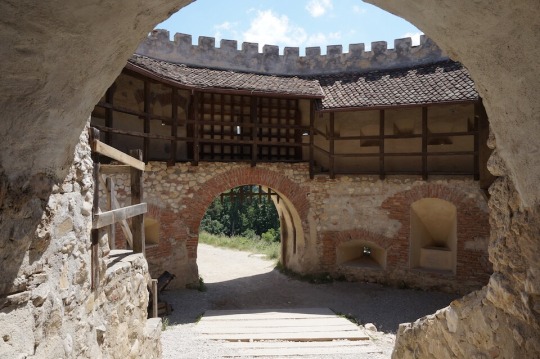
The fortress in the city of Rasnov was founded by the Teutonic Knights in 1215. It served to shelter the local population from numerous conquerors and was so fortified that it was conquered the only time in 1612 by the Transylvanian prince Gabriel Bathory. In the center is a well. A terrible legend is associated with it. During the siege by the Ottomans, the inhabitants lacked drinking water. Then they forced to dig two captured Turks another well with a depth of 62 meters.
They were promised freedom, but at the end of their work, which lasted seventeen years, the captives were killed. During restoration work, two human skeletons were actually discovered at the bottom of the well. Currently, the territory is freely visited by tourists. The fortress wall with towers and the foundation of the church remained from the fortress. A panoramic view of a two-story city and beautiful surroundings opens from the observation deck. From here you can also see Bran Castle.
Fun cemetery

The original cemetery is located in the village of Sepynets in the Maramuresh County. His tombstones are made in bright colors and have original inscriptions in poetic form. They reflect the life path of the buried villagers. This idea of the cemetery belongs to Stan Jon Patrash, a local wood carver. He was the first in 1935 to carve and erect a cross with a cheerful inscription. Over the years, more than 800 such crosses have been installed on the graveyard, and it itself has turned into a museum that tourists like to place. There is an inscription on the grave of the camp itself. It says: “In my entire life I have not done harm to anyone …”.
Mud Volcanoes

The Vulcanii Noroiosi Nature Reserve was created in the 1920s near the town of Buzau, located about 100 km from Bucharest. They arose on the territory of an abandoned mine. In 1977, an earthquake occurred in Romania, and the special activity of volcanoes began to appear. As a result of the exhaust gases, dirt and salt water are emitted to the surface. They freeze under the sun and form peaks resembling craters.
Currently, four such volcanoes are constantly operating, and twelve – periodically. Originality is given to the couple by the green hills surrounding the reserve. Between the craters are frozen flows. Their cracks on the surface of clay soil reach 5 cm. You can freely enter the territory of the reserve and spend several days in a tent camp or as part of an excursion group.
Scarisoara Cave

The Bihor Mountains are 134 kilometers from the city of Cluj-Napoca. They discovered a cave 1 km long, which was formed about 3,500 years ago as a result of glaciation. Scarisoara was first mentioned in 1863. Then the Austrian geographer Arnold Schmidl drew her map. In a grotto located in the mountains underground, a glacier is discovered, which gradually disappears as a result of melting. Stalagmites found in the halls resemble church candles.
Therefore, the cave is conditionally divided into halls called the Great Hall, Church, and Cathedral. Currently, the cave is equipped with metal and wooden stairs, which allows you to freely visit it. It is illuminated inside with carbide lamps. Some part of the cave is being studied by scientists. The temperature inside the grotto approaches zero. Therefore, when visiting attractions, you need to bring warm clothes.
Pelishor Castle

This is a small part of the Pelish complex, built in 1899-1903. It was intended as the summer residence of the heir to the Romanian throne, Ferdinand. The author of the Art Nouveau castle was the Czech architect Karel Liman. In the design of the castle, direct participation belongs to the wife of Ferdinand Princess Mary, who had a very delicate taste. She managed to successfully combine elements of the Art Nouveau style with Byzantine and Celtic symbols.
The castle has 99 rooms. They are decorated with furniture designed by Viennese designer Bernard Ludwig. In addition, the interiors were developed by him together with Queen Mary. Therefore, they have a special sophistication. In order to have a lot of light in the castle, the large windows and ceiling of the Main Hall are three floors high, decorated with stained glass windows. It is decorated with oak panels and decorated with portraits of the owners of the castle and their children.
Drimsim is the first universal sim card for travelers. Internet abroad starts at $ 1 per megabyte, and calls start at $ 3 per minute. Works in 197 countries!
Maria herself designed the furniture designs for the Golden Bedroom. It was made in 1909 in the workshop of the city of Sinai. In the Queen’s office is furniture with lilies and a Celtic cross – the symbols of the princess from Scotland. The cabinet of King Ferdinand opposite is sustained in strict German neo-Renaissance. The castle has a unique collection of works by contemporary masters of art nouveau, including designers Halle, brothers Daum, Hoffman, Tiffany, Gursner.
Sucevita Monastery
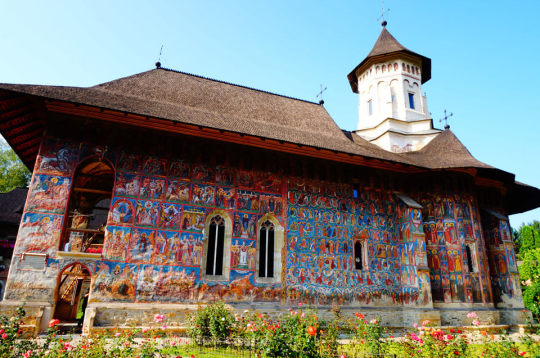
It is located in Bukovina, in the north-eastern part of the country. The nearest town of Radauti is 18 kilometers away. In 1585, it was built by brothers from the Wallachian clan Tomb of Jeremiah and Simon. The square-shaped monastery is surrounded by six-meter walls. To strengthen the corners of the tower built. In its architecture there are both Byzantine elements and Gothic. The structure inside and outside is completely covered with unique murals based on the Old and New Testaments.
They are made by Moldovan masters brothers Ion and Sofroniy with the help of a huge number of unknown masters. The unique internal painting serves the idea of spiritual renewal of a person through faith and pious deeds. In 2010, the monastery was inscribed on the World Heritage List. Currently, one of the walls is used for the museum, which houses a large exhibition of historical objects.
Mogoshoyaya Palace
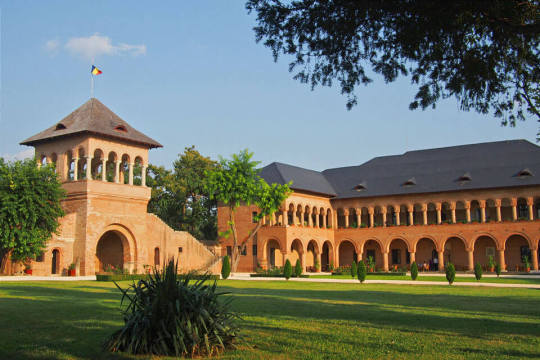
In 1698-1702, the Wallachian ruler Konstantin Brynkovyanu built a palace and park complex 16 km from Bucharest as the summer residence of his family. Constantine was the founder of a national architectural style that combined Venetian, Dalmatian and Ottoman elements. It contains numerous carved jewelry and decorative paintings. In 1714, the Ottomans executed Brynkovyan, and arranged a hotel in his palace.
Having recaptured it during the Russian-Turkish war, in 1853 the Russians arranged storage facilities for weapons in it. The princes Bibescu, who became the new owners of the palace complex, began its restoration in 1860-1880. They managed to recreate and decorate the palace, which they owned until the Second World War. In the 1920s, it belonged to the widow Marta Bibescu, who put a lot of effort into his restoration and opened a salon in it.
Its visitors were many famous people of the first half of the XX century, including Antoine Saint-Exupery. It was her name that began to be worn by the palace and park ensemble. Representatives of the princely family of Bibescu found reassurance in the church of the park. Despite significant restructuring of the 20th century, the palace has inherent basic elements of the national style. In 1957, the Museum of Brynkovets Art was opened here, including antique furniture and household items of the 17th-19th centuries, historical documents, icons and works of art.
Throne fortress
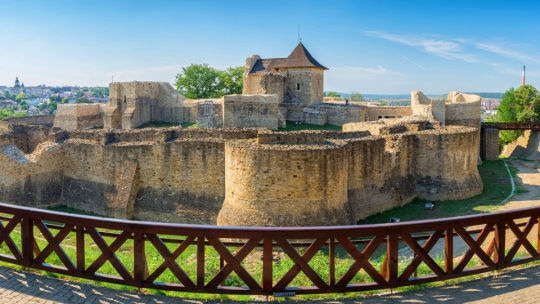
The fortress of the XIV century served as the place of coronation of Moldavian rulers. Located in the city of Suceava, it is currently a ruin. Restoration of the remains of the once powerful fortress began in 1961 and is still ongoing. The almost square fortress 40×36 meters had square towers. A water moat was dug around her. Its depth reached 10 meters. The fortress was founded by Peter I Mushat, but the greatest importance was under Stephen III the Great (Stefan cel Mare).
He strengthened two-meter walls of solid stone, built an additional defense system of walls 10 meters high, which was carried out 20-25 meters ahead. Inside, additional halls were built for members of his family. Its siege by the Ottoman forces was unsuccessful until in 1563 the self-proclaimed lord Stefan VII Tomsha took refuge in it. The mercenaries betrayed him and surrendered the stronghold to the Turks. After that, she was burned, passed from the hands of the proteges of the Turkish Sultan.
In 1675, by order of Dumitras Kantakuzin, she was blown up. Remains destroyed by an earthquake. The revival of the fortress began after archaeological research by the Austrian architect Karl Romstorfer at the beginning of the 20th century. But reconstruction began only in the 60s. Currently, the remains of the fortress can be visited for a fee.
Nyametsky fortress

During the reign of Peter I Mushat, the Nyametskaya fortress was also built. It is located near the city of Tirgu Neamt. Legends say that the Teutonic Knights first strengthened this place. They appropriated large territories in Transylvania and colonized Semigradier. The name Tirgu-Neamt is translated as “German bargaining.” Stefan the Great, preparing for the fight against the Turks, was engaged in strengthening the ring of fortresses, including Nyametskaya.
On his orders, its walls were increased by 20 meters in height and an outer courtyard was built, where artillery pieces were installed. A huge bridge was thrown across the moat, reminiscent of a Roman aqueduct and bridges of the 20th century at the same time. A well was dug in the yard to supply drinking water in case of siege. But neither the Ottomans nor the Polish commander Jan Sobesski could take her.
The Turks fell into the fortress only thanks to the conquest of Moldova, but did not begin to destroy. Left as an observation post. Currently, a small museum exposition is operating in the fortress. It presents household items of the defenders of the citadel. In 2007–09, reconstruction began. Thanks to her, a reliable road appeared for tourists placing this place, the infrastructure was improved, the architecture was updated.
Canyon Bicaz

In the Eastern Carpathians are rocks of the Bikaz gorge. It stretched between Moldova and Transylvania, and served as the only natural road. Bicaz is the deepest and longest gorge on the territory of Romania, the river of the same name shares its banks. Currently, it is a conservation area with almost sheer cliffs above an 8-km-long highway.
Taking pictures is allowed in certain areas. People driving along the highway are delighted with the surrounding beauty of nature. In 1961, a hydroelectric dam with a reservoir was built at the exit of the gorge. It is recognized as the largest Romanian lake. River trout is found in the waters of the Bikaz River, and red-winged sten climbers, considered rare birds, live on the rocks.
Ceahlau

One of the most famous mountain ranges is located in the Eastern Carpathians. It is located near Spring Lake Mountain in Neamt County. The highest points are Toaka (1904 m) and Okolashul-Mare (1907 m). The massif is surrounded by the Bistrita and Bikaz rivers, in the east – Lake Bikaz. In the national park is the monastery “Transfiguration”, and Mount Chahlau recognized as the second Christian mountain after Mount Athos. Many pilgrims flock here to visit the monks who took refuge at the top.
A beautiful legend is associated with the formation of mountains. According to her, the ruler of the Dacians of Decebal had a beautiful daughter, Docius. After the capture by the Roman emperor Trajan of Dacia, she went to the mountains of Chahlau, so as not to get to him. Here she grazed goats and froze. According to one version, the Virgin Mary turned her into a stream, and the sheep into beautiful flowers around. On the other, the girl turned into rocks. According to another legend, Emperor Trajan ordered the mountain to be poured in order to block the way for the barbarians attacking from the East.
Laku – Roshu

Near the Bikaz gorge there is a lake formed in 1837 at an altitude of 978 meters. One of the rocks was washed by heavy rains. Fallen stones formed a dam in the form of the letter “G” on the site of former pastures. The coastline of the lake is 2830 meters, and the depth reaches 10.5 meters. A beautiful fairy tale is associated with him. Nearby lived the girl Esther, whose beloved was drafted into the army.
She was very homesick, and often cried alone by the mountain stream. Here she was met by a robber and stole. The girl begged the mountains to save her, and nature took pity. The mountains shook, an earthquake killed everyone, including innocent shepherds. The collapsed rocks formed a lake with tree trunks sticking out of the water and hid the unfortunate Esther in their waters.
Canyon 7 stairs

The gorge got its name in the 20s of the XX century, when transitions for the local population were stretched here. They stretched for 230 meters with a height difference of 55-60 meters. It takes place as part of groups without special equipment. From time to time there are small waterfalls on the route, additionally spraying tourists with water.
Scientists attribute the formation of the canyon to the Jurassic period. It is assumed that its bottom is the base of the ancient sea, on the banks of which dinosaurs lived. In addition to the marvelous nature, legends ascribe miracles to the canyon. Young people, to test their future wives, invited the girls to walk along the bottom of the canyon. Thus, they figured out her stamina. Then the girls were invited to spend the night over it themselves, climbing seven stairs upstairs.
If during the test the young couples did not quarrel, but helped each other, a long happy life awaited them. And in our time there are daredevils repeating the teachings of an ancient tradition. The atmosphere of the gorge is filled with very ozonized air, which kills all conceivable infections, thereby contributing to a strong healing effect.
Retezat National Park

This is the first national park in Romania, founded in 1935. The main reason for the formation of the protected area was the desire to preserve the unique alpine vegetation. On an area of 381 km², located at an altitude of 2000 meters above sea level, traces of glacial lakes are preserved. It is here that the deepest Romanian Lake Zanoaga is located. At an altitude of 2509 meters is the peak of Peleaga Mountain.
1190 species of flora were found in the park, 90 of which are endemic. Alder, rhododendron, nibs, bluegrass, and hawk grow here. The reserve is the birthplace of many wild animals. Among them are brown bear, forest cat, lynx, wolves. A large number of birds live in it: a horned lark, a brown vulture, a rare golden eagle, a white-throated thrush, and many others. Because of them, the national reserve is declared a specially protected zone.
Piatra Craiului National Park
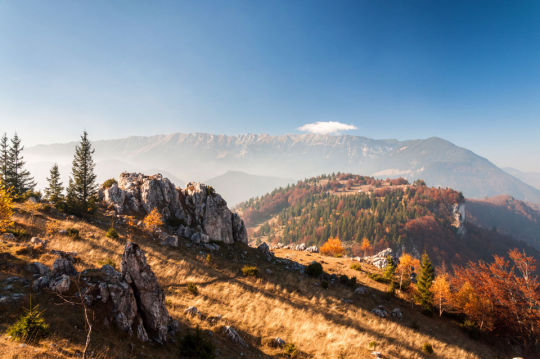
200 kilometers north of Bucharest in the Southern Carpathians is another interesting corner of Romania. The date of the formation of the protected area is considered to be 1938, which in 1990 became a national park. The total area of the reserve is 14,781 ha. Its karst landscape with the release of limestone rocks is distinguished by various representatives of the plant and animal world. Among 1170 species of vegetation, pine and willow, alder, hornbeam, and oaks are found.
48 species of members of the orchid family grow. Among the representatives of the living world of birds alone, there are 11 species. This is thrush, cuckoo, oriole, kayuki, golden eagle and many others. But there are only 3 species of fish: barbel, brook lamprey and sculpin. Walking routes are organized for any physical condition. They allow plenty to admire the beauties of Romanian nature: mountain gorges, valleys and glacial lakes.
Mountain range Rodna

Another Romanian mountain range near the Ukrainian border. It is formed by granites and crystalline rocks. Pyrite deposits were discovered here. On the territory of the massif is Rodna National Park with an area of 46599 ha. It was created in 2000 and represents a unique territory of glacial cracks and caves, valleys, forests and mountain pastures. Some of the inhabitants of the park are protected by law. Common mammals include brown bear, wolves, lynx, capercaillie and eagle.
Sarmizegetusa
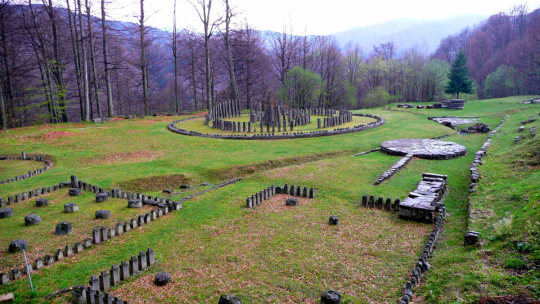
In the south-west of Transylvania was the territory of Dacia. The residence and its main military and political center was Sarmisegetusa, located on the hill of Gradistia-Munchelului. It received such an interesting name in honor of the ceasefire between the Sarma and Getae tribes. The last Dacian ruler Decebalus included it in his defensive system. It was destroyed by Roman troops during the campaigns. In 1999, the remains of Sarmizegetusa were included in the UNESCO World Heritage List.
The fortress was located at an altitude of 1200 meters above sea level, had a quadrangular shape and occupied 30,000 m². In addition to defensive significance, it was also a religious center, since it contained important shrines for the Dacians. It is assumed that the cave on Mount Kogayonon located here served as a shelter for the god Zalmoxis. At the top, several sacred shrines were discovered, the road to which is paved with tightly fitting parallelepiped stones. Ceramic pipes were laid into the houses located on the mountain terraces, through which water flowed. This led to the conclusion about the high culture of life of the Dacian tribes.
Vidraru Dam
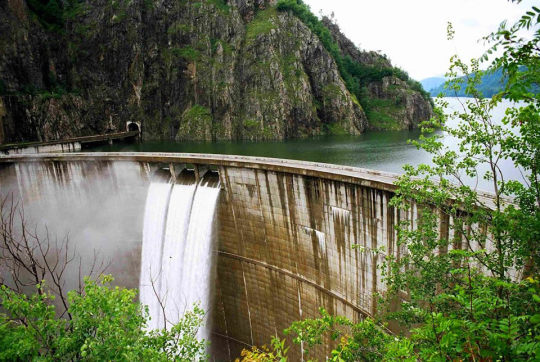
In 1961-66, a dam was built on the Arges River, flooding the village of Arges Arefu. The area of the artificial lake is 870 ha. It is the highest dam in Romania. It has a shape resembling a bow up to 167 meters high and 305 meters long. At the time of commissioning in the 60s of the XX century, the dam was considered the ninth largest in the world and the fifth in Europe. Currently, the dam is undergoing major repair and reconstruction work to modernize and strengthen existing facilities. An observation deck with the iron figure of Prometheus, which was previously allowed to climb the stone stairs, was built near the dam.
Currently, guards are working around the dam, as a large amount of explosives is located on the slopes of the mountains in case water breaks. In this case, it will be easier to create an artificial barrier to prevent the accident as soon as possible. Boat trips and bungee jumping, resembling a bungee, are organized around the reservoir.
Bucegi Sphinx

In the mountains of Bucegi, located in the center of the country, at an altitude of 2216 meters there is an interesting natural formation. It is very similar to the Egyptian sphinx. As a result of weathering of sandstone and calcareous rocks by winds, such a miracle formed in the Southern Carpathians. It is assumed that in this area was one of the centers of Atlantis, where there were landing sites of an alien civilization. In the city of Iasi, a clairvoyant lives, claiming that under the Sphinx there is a labyrinth that hides treasures with the knowledge of an ancient civilization that will be revealed to mankind when it is ready for this. The Bucegi Sphinx is listed as the country’s seven natural wonders.
Curtea Veke
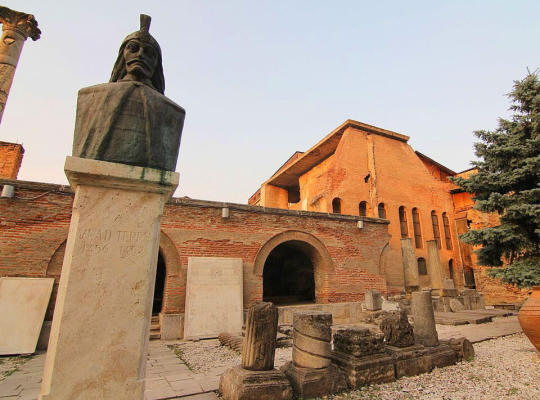
The Old Courtyard (rum. Curtea Veche – Old Courtyard), or the Princely Court (rum. Curtea Domnească din Bucureşti) is a complex of buildings designed to serve the Wallachian rulers. It was built in the second half of the 14th century by the ruler Mircea Sary. After his death was not used. In the XV century, Vlad Tepes decided to found the Dymbovitsa fortress on its ruins.
Laid on September 20, 1459 from stone, the fortress is considered the foundation of Budapest. After him, special attention was paid to the fortress after 1545 under Mircea Chobanul, who was laying the church of St. Anton (hramul Sf Anton) and the Annunciation (de Buna Vestire). Later, coronations of Romanian rulers were held in it. This is currently the oldest building in Bucharest.
The fires and natural disasters led to the desolation of the palace and the transfer of the government residence to another place, and this fortress was called the Old Courtyard. Currently, it is an open-air museum telling about the past of the Romanian capital. Here you can see the remains of the water supply system, murals and decorations of the building, fragments of the defensive fortifications and the gallery of the Court, as well as a Turkish bath built on its territory.
#Bran Castle#Canyon 7 stairs#Canyon Bicaz#Ceahlau#Corvin Castle#Fun cemetery#Laku - Roshu#Mogoshoyaya Palace#Mountain range Rodna#Mud Volcanoes#Nyametsky fortress#Peles Castle#Pelishor Castle#Piatra Craiului National Park#Poenari#Rasnov Fortress#Retezat National Park#Romanian Athenaeum#Sarmizegetusa#Scarisoara Cave#Sucevita Monastery#Throne fortress
0 notes